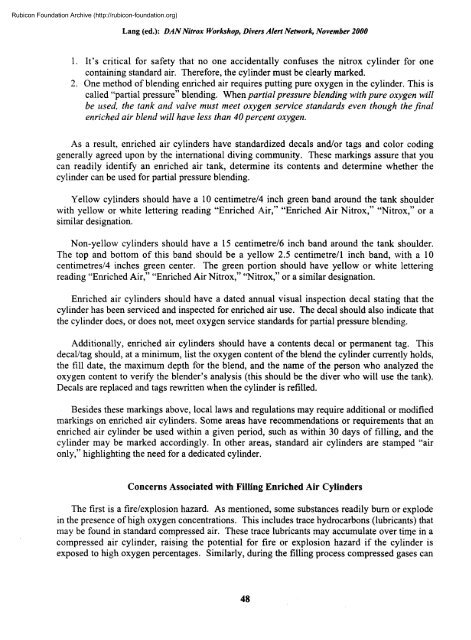Nitrox workshop dings - Divers Alert Network
Nitrox workshop dings - Divers Alert Network
Nitrox workshop dings - Divers Alert Network
Create successful ePaper yourself
Turn your PDF publications into a flip-book with our unique Google optimized e-Paper software.
Rubicon Foundation Archive (http://rubicon-foundation.org)Lang (ed.): DAN <strong>Nitrox</strong> Workshop, <strong>Divers</strong> <strong>Alert</strong> <strong>Network</strong>, November 20001. It's critical for safety that no one accidentally confuses the nitrox cylinder for onecontaining standard air. Therefore, the cylinder must be clearly marked.2. One method of blending enriched air requires putting pure oxygen in the cylinder. This iscalled "partial pressure" blending. When partial pressure blending with pure oxygen willbe used, the tank and valve must meet oxygen service standards even though the finalenriched air blend will have less than 40 percent oxygen.As a result, enriched air cylinders have standardized decals and/or tags and color codinggenerally agreed upon by the international diving community. These markings assure that youcan readily identify an enriched air tank, determine its contents and determine whether thecylinder can be used for partial pressure blending.Yellow cylinders should have a 10 centimetre/4 inch green band around the tank shoulderwith yellow or white lettering reading "Enriched Air," "Enriched Air <strong>Nitrox</strong>," "<strong>Nitrox</strong>," or asimilar designation.Non-yellow cylinders should have a 15 centimetre/6 inch band around the tank shoulder.The top and bottom of this band should be a yellow 2.5 centimetre/1 inch band, with a 10centimetres/4 inches green center. The green portion should have yellow or white letteringreading "Enriched Air," "Enriched Air <strong>Nitrox</strong>," "<strong>Nitrox</strong>," or a similar designation.Enriched air cylinders should have a dated annual visual inspection decal stating that thecylinder has been serviced and inspected for enriched air use. The decal should also indicate thatthe cylinder does, or does not, meet oxygen service standards for partial pressure blending.Additionally, enriched air cylinders should have a contents decal or permanent tag. Thisdecal/tag should, at a minimum, list the oxygen content of the blend the cylinder currently holds,the fill date, the maximum depth for the blend, and the name of the person who analyzed theoxygen content to verify the blender's analysis (this should be the diver who will use the tank).Decals are replaced and tags rewritten when the cylinder is refilled.Besides these markings above, local laws and regulations may require additional or modifiedmarkings on enriched air cylinders. Some areas have recommendations or requirements that anenriched air cylinder be used within a given period, such as within 30 days of filling, and thecylinder may be marked accordingly. In other areas, standard air cylinders are stamped "aironly," highlighting the need for a dedicated cylinder.Concerns Associated with Filling Enriched Air CylindersThe first is a fire/explosion hazard. As mentioned, some substances readily burn or explodein the presence of high oxygen concentrations. This includes trace hydrocarbons (lubricants) thatmay be found in standard compressed air. These trace lubricants may accumulate over time in acompressed air cylinder, raising the potential for fire or explosion hazard if the cylinder isexposed to high oxygen percentages. Similarly, during the filling process compressed gases can48
















